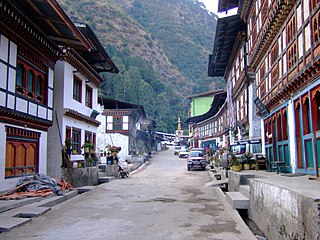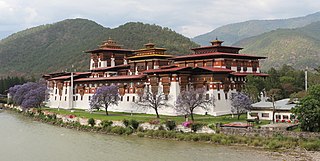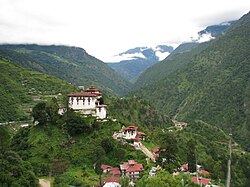
Paro District is a district (dzongkhag), valley, river and town in Bhutan. It is one of the most historic valleys in Bhutan. Both trade goods and invading Tibetans came over the pass at the head of the valley, giving Paro the closest cultural connection with Tibet of any Bhutanese district. The dominant language in Paro is Dzongkha, the national language.

Lhuentse District is one of the 20 dzongkhag (districts) comprising Bhutan. It consists of 2506 households. Located in the northeast, Lhuentse is one of the least developed dzhongkhags of Bhutan. There are few roads, the first gas station was opened in September 2005, electricity is not well distributed, and the difficult terrain makes distribution of social welfare problematic. Despite its favorable climate, farming is hindered by the lack of infrastructure.
Articles related to Bhutan include:

Gasa Dzong༼མགར་ས།༽ or Gasa Tashi Tongmön Dzong near Gasa is the administrative center of Gasa Dzongkhag (district) in the northwestern region of Bhutan. The Dzong was built in the 17th century by Tenzin Drukdra the second Druk Desi over the site of a meditation place established by Drubthob Terkungpa in the 13th century. The Dzong was constructed as a bulwark against attacks from the north and named Tashi Tongmön Dzong. It was later expanded by the fourth Desi, Gyalse Tenzin Rabgye. Inside the Guardian's Temple he placed ritual object and performed the consecration ceremony.

Trashigang, or Tashigang, meaning "fortress of auspicious mount," is a town in eastern Bhutan and the district capital of the Trashigang Dzongkhag (district).

Rinpung Dzong, sometimes referred to as Paro Dzong, is a large dzong - Buddhist monastery and fortress - of the Drukpa Lineage of the Kagyu school in Paro District, Bhutan. It houses the district Monastic Body as well as government administrative offices of Paro Dzongkhag. It is listed as a tentative site in Bhutan's Tentative List for UNESCO inclusion.

Tenzin Rabgye (1638–1696) was the fourth Druk Desi who ruled from 1680 to 1694. He is believed to have been the first to have categorized formally the zorig chusum. In 1688, he renovated Tango Monastery, approximately 14 kilometres from Thimphu. In 1692, he was first formally categorized during the rule of Tenzin Rabgye (1680–1694), the 4th Druk Desi. In 1692, he visited the sacred cave of Taktsang Pelphug during the Tsechu season and founded a temple there devoted to Padmasambhava. The temple is known as Taktsang Lhakhang and was completed in 1694.

Gasa is a town near Gasa Dzong in Gasa District in northwestern Bhutan.

Paro Taktsang, is a sacred Vajrayana Himalayan Buddhist site located in the cliffside of the upper Paro valley in Bhutan. It is one of thirteen Tiger's Nest caves in historical Tibet in which Padmasambhava practiced and taught Vajrayana.

The Punakha Dzong, also known as Pungthang Dewa chhenbi Phodrang, is the administrative centre of Punakha District in Punakha, Bhutan. Constructed by Ngawang Namgyal, 1st Zhabdrung Rinpoche, in 1637–38, it is the second oldest and second-largest dzong in Bhutan and one of its most majestic structures. The dzong houses the sacred relics of the southern Drukpa Lineage of the Kagyu school of Tibetan Buddhism, including the Rangjung Kharsapani and the sacred remains of Ngawang Namgyal and the tertön Pema Lingpa.

Lhuentse Dzong is a dzong and Buddhist monastery in Lhuentse District in eastern Bhutan. It lies on the eastern side of the Kuri Chhu and is perched on a spur at the end of a narrow valley.

The Kuri Chhu, also known as the Lhozhag Xung Qu or Norbu Lag Qu, is a major river of eastern Bhutan, that has formed a scenic valley with high peaks and steep hills. Kuri Chhu is a tributary of the Manas River system, which is the largest river of Bhutan and a major tributary of the Brahmaputra River that drains most of eastern Bhutan.

Kurtoed Gewog is a gewog of Lhuntse District, Bhutan. It is inhabited by speakers of the Kurtöp language.

Trongsa Province was one of the nine historical Provinces of Bhutan.

Bumthang Province was one of the nine historical Provinces of Bhutan.

Kurtoed Province was one of the nine historical Provinces of Bhutan.

Kurmaed Province was one of the nine historical Provinces of Bhutan.

Desi Jigme Namgyal of Bhutan is a forefather of the Wangchuck Dynasty. He served as 48th Druk Desi of Bhutan (1870–1873), and held the hereditary post of 10th Penlop of Trongsa. He was called the Black Ruler.

Trashigang Dzong is one of the largest dzong fortresses in Bhutan, located in Trashigang in Trashigang District of Bhutan. The fortress was built in 1659 to defend against Tibetan invasions. The dzong hosted a monastic community besides acting as the central administrative center of the Trashigang District, before they were shifted due to the ongoing restoration.
Chogyal Minjur Tempa was the third Druk Desi, the secular head of Bhutan, and previously the first penlop (governor) of Trongsa (Trongsab). His tenure as penlop was notable for the building of a watchtower and the unification of eight Eastern Districts into the Sharchog Khorlo Tsibgye.















